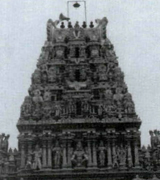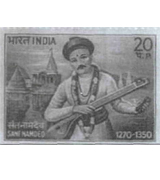Heritage
Parthasarathy Temple In Tiruvallikeni

Tiruvallikeni or Triplicane, as the English called it, happens to be one of the oldest parts of Madras City. The existence of a village of that name is seen in records dating back to the Pallava period and earlier. Triplicane as an area merits a separate study as a Sangeetha Sthalam by itself. This account restricts itself to the temple that forms the core of this area and which in its own way shaped our musical heritage.
The origins of the temple are steeped in myth. It is believed that the area got its name from a sacred (tiru) tank (keni) of lilies (alii) that once existed here, in the midst of a forest of tulasi bushes. Due to the tulasi plants, the place was also referred to as Brindaranya Kshetram. Today, the sacred temple tank which dominates the square in front of the temple goes by the same name. The temple is said to have existed on the bank of a river that once flowed in these parts, called the Kairaveni. Today the tank is also referred to as Kairaveni.
MAIN FEATURE
Creativity in Raga Alapana - Part 1 - P.K. DORAISWAMY The Pride, Puzzle and Paradox of Carnatic Music 1. The raga is the life and soul of Indian classical music. Professor Sambamoorthy calls raga-based music absolute music. No other music system in the world, we claim proudly, is comparable to ours in the extent and depth of spontaneous, continuous creativity. What jazz and some folk styles do is mere superficial improvisation in specific tunes and without an overarching conceptual framework such as the raga. Creativity is expected to be the least in the singing of kriti-s (known as kalpita sangeeta), and much more in the singing of niraval, swaram and tanam. But it is raga alapana that is considered the pinnacle of manodharma sangeeta. 2. This article was inspired by the following, somewhat alarming, thought experiment: "Suppose we listen to a typical, reasonably elaborate alapana of any raga by a leading musician. Ignoring purely ornamental sangati-s and briga-s, what percentage, on an average, of his raga-bhava-enhancing sanchara-s will be those which we have never heard before?.... 3. What exactly is this creativity in alapana that all of us are proud of? What is our norm for identifying genuine creativity and labelling it so? How pervasive or rare is it? How deep or superficial is it? What minimum of it is essential before an alapana qualifies to be rated as creative? Even where creativity exists, is its degree and duration exaggerated or overrated? These questions are fascinating but when one tries to answer them and pin down the concept and criteria of creativity, they turn out to be puzzling and paradoxical. What follows is essentially an exploration of the above and related questions and is not to be taken as prescriptive or definitive answers to them. 4. What would be an ideal alapana (if there is one)? Is it one which: (i) consists wholly of newly-created, never-sung-before sanchara-s, or (ii) has a strong base of traditional sanchara-s with an elaborate superstructure of newly-created sanchara-s, or (iii) has a predominant foundation of traditional sanchara-s with a moderate dose of newly-created sanchara-s, or (iv) consists mostly of traditional sanchara-s interspersed with novel surface-level embellishments (sangati-s), or (v) consists wholly of traditional, established sanchara-s?...... 6. Conceptually, one could distinguish four broad levels of creativity in expounding raga-s: (a) conceiving a raga (assuming that what is created is accepted as a raga according to classical norms), (b) establishing its unique swaroopa, by exploring it and identifying its distinctive, dominant, defining sanchara-s, (c) extending its aesthetic frontiers by developing new perspectives on it (assuming this is possible), and (d) embellishing familiar sanchara-s at the surface-level with original sangati-s (i.e. alankara-s or anatomical ornamentations) in order to impart variety, glitter and tempo..... 7. Operationally, one could evaluate creativity in raga exposition at three levels of strictness: (i) invented, never-sung-before sanchara-s which provide new perspectives on the raga thus extending its aesthetic frontiers beyond the already familiar; ii) any improvised, novel embellishments to familiar sanchara-s conforming to the grammatical structure of the raga, even if they are only surface level sangati-s or are not unique to the raga and as a pattern are applicable to other raga-s; (iii) any unpremeditated, spontaneous sanchara which occurs to a musician even if it has been sung by him or other musicians earlier, or does not enlarge the aesthetic frontiers of the raga beyond the already familiar. Depending on which of the above definitions one adopts, one would evaluate the degree of creativeness in raga alapana as high or low. It would appear that, in practice, each of these criteria is adopted by different rasika-s and reviewers according to their own knowledge, tastes and preferences, and there is no unanimity or uniformity.
A Series For Youngers
Stamp On Namdeo

The stamp on Namdeo was issued on 9 November 1970, on his 700th birth anniversary. It is in the denomination of 20 P., with a perf. of 13 x 13, and in orange colour. It was printed on 'Asoka Pillar' water-marked adhesive stamp paper at the India Security Press, Nashik by photogravure process. The stamp depicts Namdeo in a devotional mood, holding a tanpura and chipla in his hands. In the background is Lord Vithoba's shrine.
NEWS & NOTES
MAKING A DIFFERENCE THROUGH DANCE In Chennai - S. JANAKI On 26th December 2004 the tsunami waves crashed into the Chennai coastline spreading death and devastation. At Srinivasapuram in Pattinapakkam near Foreshore Estate, the giant waves flooded the huts on the beach and destroyed the boats of the fisherfolk. The boundary wall of the Meenavar Samudaya Koodam (Fishermen Community Hall) was washed away as the swirling waters swept past it into the ground floor flats beyond. 'The Art of Living' volunteers (followers of Sri Sri Ravishankar) who were interacting with the fisherfolk in the area even before December 2004 decided to adopt the ravaged fishing hamlets in the area and swung into action. They launched reconstruction and rehabilitation measures after the tsunami to help the people get over the trauma. They held group singing sessions there and also helped to reconstruct the damaged Samudaya Koodam. The renovated hall with a new boundary wall was formally inaugurated by Akhila Srinivasan, Managing Director of the Shriram Group of Companies on 30th April. It was an evening of music and dance which brought cheer to the fisherfolk.


